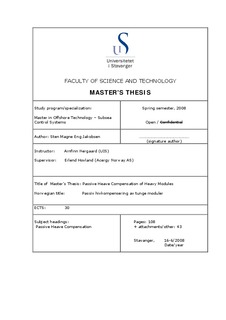| dc.contributor.author | Jakobsen, Sten Magne Eng | |
| dc.date.accessioned | 2008-10-31T11:50:55Z | |
| dc.date.issued | 2008 | |
| dc.identifier.uri | http://hdl.handle.net/11250/182671 | |
| dc.description | Master's thesis in Offshore structural engineering | en |
| dc.description.abstract | New subsea technology has increased size and weight of installed modules
significantly. This thesis looks at heavy module installation from barge, through
moonpool with use of passive heave compensation.
An installation barge is designed with moonpool used as working platform for
installation. Motion responses for barge are analyzed with use of marine
engineering software MOSES. Responses found shows a significantly impact from
moonpool, and it doubtingly if software is capable of calculate actual barge. Motion
response found is used in operational analysis of compensator.
Mathematical models of first and second order are established to evaluate chosen
passive compensator. Models calculate residual motion of module under a given
harmonic force with respect to frequency ω.
Two first order models are established with use of different theories, transfer
function and motion of equation. System is simplified and evaluated model results
correspond well. Transfer function model is evaluated for varying variables. Results
show that resonance frequency has a large impact on compensator performance.
Resonance frequency is determined by compensator stiffness and module mass,
following compensator stiffness are important for compensator performance.
One second order model is evaluated and includes some of the simplifications
made for first order system. The second model gives a more accurate view of the
physical situation.
Calculations show that all three models correlate well, where largest difference
between models is in resonance area. The passive compensator works best for high
ω, in contrast to compared semi-active compensator.
Calculations shows that model for motion of equation are most conservative, while
the second order models gives largest changes for changing water depth.
Results are based on theoretical evaluations and model test should be performed to
conclude if models represents physical situation.
Designed system should fulfil installation criteria’s for modules given by a max
velocity for landing. Evaluated barge has largest velocities for lowest values of ω.
Without compensation the barge Hs for installation is below 1m Hs, and defined as
low. Compensator with evaluated inputs is not able to reduce the highest velocities,
and does not increase the weather window significantly.
Compensator does not increase weather window for operation, and inputs should
be analysed. System should be designed to meet barges motion response. | en |
| dc.format.extent | 2016036 bytes | |
| dc.format.mimetype | application/pdf | |
| dc.language.iso | eng | en |
| dc.publisher | University of Stavanger, Norway | en |
| dc.relation.ispartofseries | Masteroppgave/UIS-TN-IKM/2008 | en |
| dc.subject | Passive heave compensation | en |
| dc.subject | offshore konstruksjonsteknikk | |
| dc.title | Passive heave compensation of heavy modules | en |
| dc.type | Master thesis | en |
| dc.subject.nsi | VDP::Technology: 500::Marine technology: 580::Offshore technology: 581 | en |
